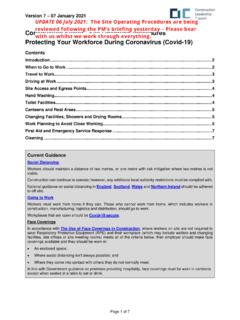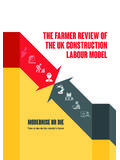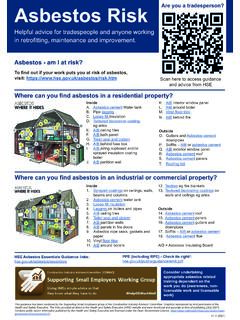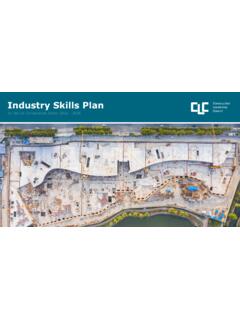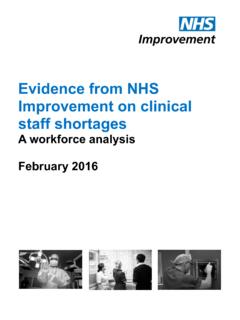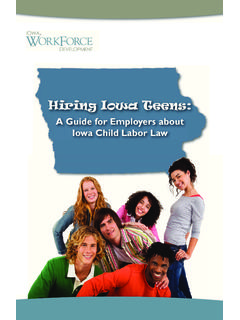Transcription of Construction Sector - Site Operating Procedures Protecting ...
1 Reference Document 19 July 2021 Page 1 of 7 Construction Sector - Site Operating Procedures Protecting Your workforce during Coronavirus (Covid-19) The Site Operating Procedures have always reflected the latest Government guidance. Whilst COVID-19 remains widespread across the UK and will need to be managed for some time to come, the lifting of the remaining legal restrictions, including social distancing requirements, from 19 July 2021 means that the Site Operating Procedures are no longer current and remain available as a reference document. The Use of Face Coverings in Construction has been updated in line with the latest Government guidance that face coverings should be worn in crowded and enclosed spaces when people mix with others that they don t normally meet.
2 Contents Introduction .. 2 When to Go to Work .. 2 Travel to Work .. 3 Driving at Work .. 3 Site Access and Egress Points .. 4 Hand Washing .. 4 Toilet Facilities .. 4 Canteens and Rest Areas .. 5 Changing Facilities, Showers and Drying Rooms .. 5 Work Planning to Avoid Close Working .. 5 First Aid and Emergency Service Response .. 7 Cleaning .. 7 Reference Document 19 July 2021 Page 2 of 7 Introduction These Site Operating Procedures (SOP) are based on Government guidance on Working safely during Coronavirus (Covid-19) - Construction and other outdoor work in England; other restrictions and advice may apply in Scotland, Wales and Northern Ireland, as well as in areas subject to a localised lockdown.
3 The objective is to introduce consistent measures on Construction sites of all types and sizes and employers and individuals should make every effort to comply. Where workers enter people s homes, they should follow the Government guidance on Working in Other People s Homes. The HSE is the relevant enforcing authority for occupational health and safety legislation and guidance to control public health risks in the Construction Sector . If a site is not complying with the latest Government advice on Coronavirus (Covid-19), it may be subject to enforcement action. Construction sites need to ensure they are Protecting their workforce and minimising the risk of spread of Coronavirus (Covid-19) infection.
4 This includes considering how personnel travel to and from site. Government guidance for employers in England states where the social distancing guidelines cannot be followed in full, even through redesigning a particular activity, businesses should consider whether that activity needs to continue for the business to operate, and, if so, take all the mitigating actions possible to reduce the risk of transmission between staff . The health and safety requirements of any Construction activity must not be compromised. If an activity cannot be undertaken safely, it should not take place.
5 Organisations must have in place effective arrangements for monitoring and reviewing their compliance with Government and industry guidance. The workforce should be reminded during inductions and daily briefings of the specific social distancing and Coronavirus (Covid-19) control measures necessary to protect them, their colleagues, families and the UK population. When to Go to Work It is important to understand the following guidelines by which workers should or should not travel to work as outlined below. Social distancing Workers in the Construction industry should follow the guidance on Social Distancing.
6 Where they cannot work from home, they must follow guidance on Meeting With Others Safely and Safer Travel while travelling to and from work and while at work. Anyone who is clinically extremely vulnerable to Coronavirus (Covid-19) should follow the latest guidance on shielding. Self-isolation Anyone who has: symptoms of Coronavirus (Covid-19); received a positive Coronavirus (Covid-19) test result; a member of their household or support bubble showing symptoms of Coronavirus (Covid-19) or with a positive test result; returned from a country that is not on the travel corridor list; or been contacted by the NHS Test & Trace Service; must follow the guidance on self-isolation and should not come to site.
7 It is a legal requirement to self-isolate in the event of a positive test result or when told to do so by NHS Test & Trace If someone falls ill If a worker develops symptoms of Coronavirus (Covid-19) whilst at work, they should: Ensure their manager or supervisor is informed Return home immediately Avoid touching anything Reference Document 19 July 2021 Page 3 of 7 Cough or sneeze into a tissue and put it in a bin, or if they do not have tissues, cough and sneeze into the crook of their elbow. They should get a Coronavirus (Covid-19) test. They must follow Stay at home: guidance for households with possible or confirmed coronavirus (COVID-19) infection and not return to site until they have received a negative test result or, in the event of a positive test result, until they have completed their period of self-isolation and are no longer unwell.
8 Sites that identify five or more cases within 14 days will need to contact their local Public Health England protection team. Further information can be found in the What to do if a worker has Covid-19 or has to self-isolate flowchart. Travel to Work Using Private Vehicles Wherever possible workers should try not to share a vehicle with those outside their household or support bubble. If workers have no option but to share transport, they should try to: Share with the same individuals and with the minimum number of people (up to a maximum of 6) at any one time Keep the windows open Travel side by side or behind other people, rather than facing them, where seating arrangements allow Maximise the distance between people Wear a face covering The vehicle should be cleaned between journeys, especially touch points, using gloves and standard cleaning products.
9 Using Public Transport Where public transport is the only option for workers, they: Should try to avoid travelling during peak times (05:45 08:15 and 16:00 17:30); and Must wear a face covering. Sites should consider: Changing and staggering site hours to reduce congestion on public transport Parking arrangements for additional vehicles and bicycles Providing facilities such as lockers and showers Providing hand cleaning facilities at entrances and exits. This should be soap and water wherever possible or hand sanitiser if soap and water are not available How someone taken ill would get home.
10 Driving at Work When travelling at work or between site locations, workers should travel alone. If workers have no option but to share a vehicle, then they should follow the Government guidance on Working Safely during Coronavirus (Covid-19) - Vehicles, which provides information for people who work in or from vehicles, including couriers, mobile workers, lorry drivers, on-site transit and work vehicles, field forces and similar. Reference Document 19 July 2021 Page 4 of 7 Site Access and Egress Points Stop all non-essential visitors Consider introducing staggered start and finish times to reduce congestion and contact at all times Plan and manage site access and egress points to enable and control social distancing you may need to change the number of access points, either increase to reduce congestion or decrease to enable monitoring, including in the case of emergencies Introduce one-way systems Allow plenty of space between people waiting to enter site Use signage.
